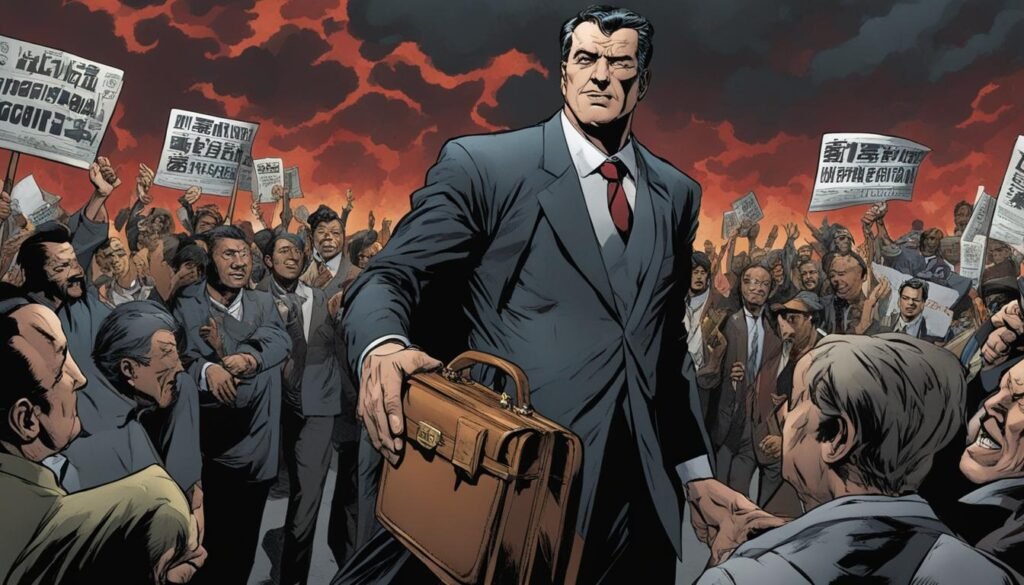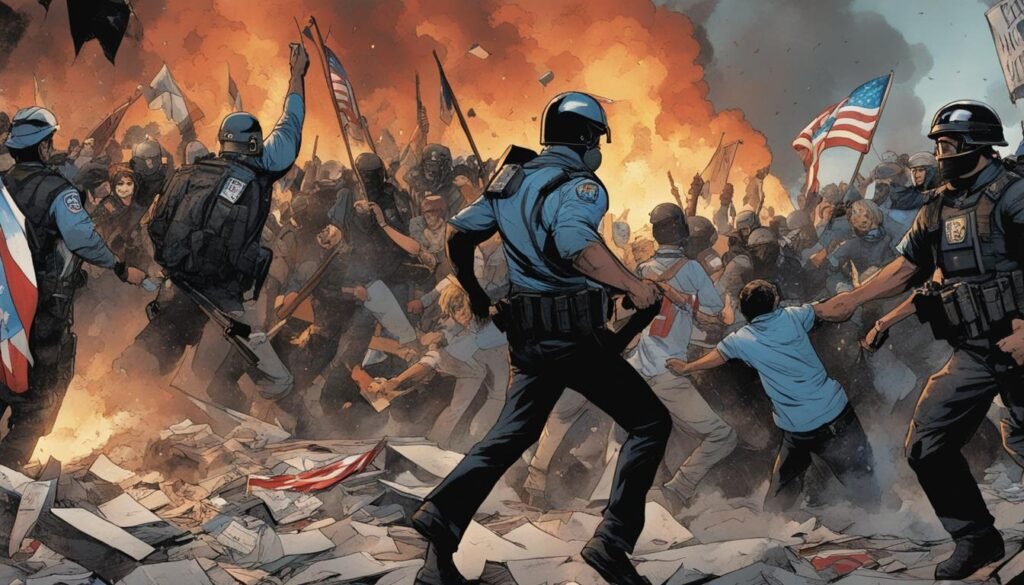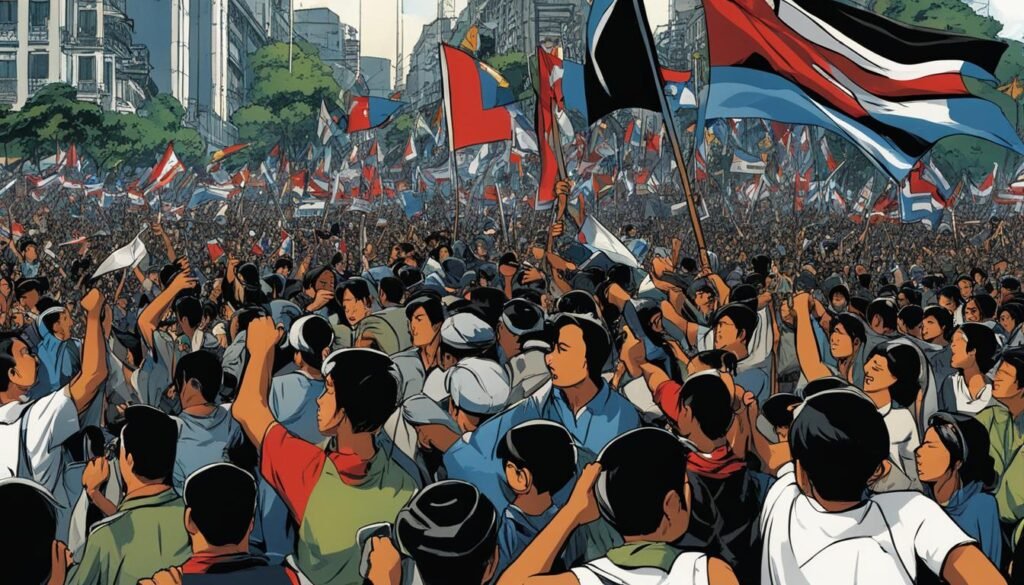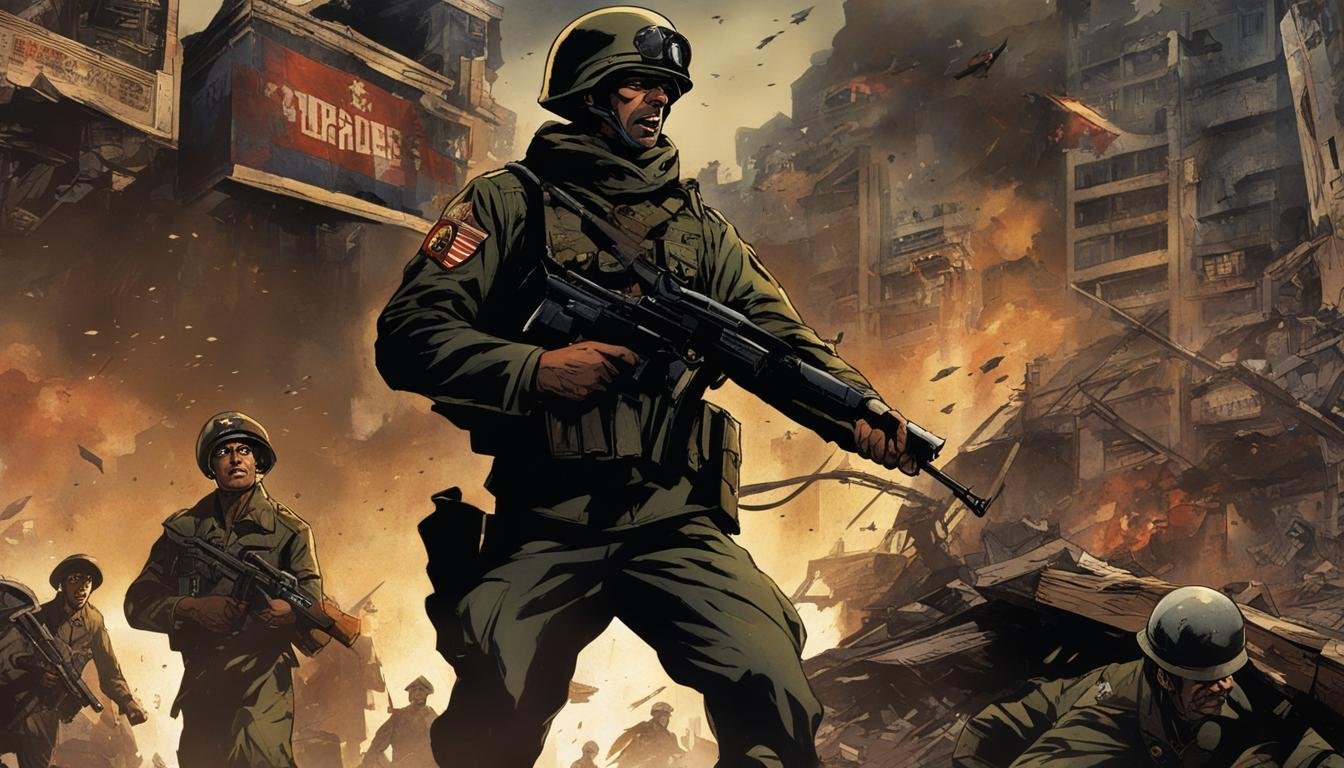The Marcos regime in the Philippines from 1965 to 1972 marked a period of increasing authoritarianism and corruption. Led by President Ferdinand Marcos, the regime ushered in a time of political repression, human rights abuses, economic challenges, and widespread cronyism.
While the early years of Marcos’ presidency saw a focus on industrialization and infrastructure development, concerns were raised about the ballooning armed forces budget and allegations of military influence in civilian government offices. Marcos’ opposition to sending military forces to Vietnam during the Vietnam War also raised eyebrows.
Despite early economic growth, the Marcos administration faced debt crises and recurring recessions that exacerbated poverty and created a climate of instability. Opposition to Marcos’ rule grew, leading to protests and civil unrest.
Key Takeaways:
- Marcos regime brought about an era of increasing authoritarianism and corruption in the Philippines.
- Early economic growth was overshadowed by debt crises and recurring recessions.
- Civil unrest and opposition movements grew as human rights abuses and corruption became more prevalent.
- Marcos declared martial law in 1972, suppressing civil rights and media freedom.
- The Marcos era left a lasting impact on the Philippines, with ongoing efforts to seek justice and accountability.
The Declaration of Martial Law
On September 23, 1972, Ferdinand Marcos, the President of the Philippines, proclaimed martial law through Proclamation No. 1081. This declaration marked a critical turning point in the country’s history, as it cemented Marcos’ grip on power and ushered in a period of authoritarian rule.
Marcos justified the imposition of martial law by citing the perceived threats of the Communist Party of the Philippines and the rebellion of the Muslim Independence Movement. However, these justifications were heavily criticized by opposition figures who accused Marcos of using them to consolidate power and extend his presidency beyond the limits set by the constitution.
Martial law granted Marcos vast and unparalleled control over various state institutions, particularly the armed forces and the police. It allowed him to suppress civil rights, impose media censorship, and violate human rights with impunity. The dictatorship that followed saw the erosion of democratic institutions, the stifling of dissent, and the rise of cronyism.
Under martial law, opposition figures, activists, and journalists were arrested, tortured, and silenced, while the fate of countless others remains unknown. This period witnessed a blatant disregard for human rights and a systematic suppression of those who dared to oppose the regime.
“Martial law came to symbolize a dark chapter in the history of the Philippines—a period marred by dictatorship, human rights abuses, and the concentration of power in the hands of one man.”
The declaration of martial law and the subsequent dictatorship sparked resistance from various sectors of society. Students, religious workers, indigenous communities, and workers all played a role in opposing the authoritarian regime. Protests and demonstrations became a common sight as Filipinos bravely stood up for their rights, defying the oppressive environment.
Despite the suppression, the opposition persisted and fought for democracy throughout the dark period of martial law. Figures like Benigno Aquino Jr. and Jose W. Diokno courageously spoke out against Marcos’ abuses, becoming icons of defiance and inspiration.
It is essential to remember the declaration of martial law as a stark reminder of the threats posed by unchecked power, the erosion of civil liberties, and the dangers of authoritarian regimes. The lessons learned during this tumultuous period in Philippine history continue to shape the nation’s commitment to preserving democracy, upholding human rights, and preventing the repetition of past atrocities.
Economic Impact of the Marcos Regime
The economic performance of the Philippines during the Marcos regime had a mixed outcome, with periods of both growth and severe recessions. While there were instances of high GDP growth in 1973 and 1976, the years following the assassination of Benigno Aquino Jr. in 1983 witnessed a significant contraction. The Marcos administration heavily relied on debt-driven growth, which resulted in an alarming increase in external debt. Poverty levels worsened during this period, leading to an increase in the number of impoverished families. The population also grappled with inflation and soaring prices of basic commodities.
Despite intermittent periods of economic growth, the Marcos regime’s legacy is marked by its detrimental impact on the Philippines’ economic stability and the welfare of its people.
Corruption and Cronyism
The Marcos regime was marked by rampant corruption and cronyism, with Ferdinand Marcos and his cronies amassing staggering amounts of ill-gotten wealth. Estimates suggest that Marcos stole between $5 billion and $10 billion from the country’s coffers, making it one of the most significant government robberies in history. When the Marcos family fled the Philippines after the People Power Revolution in 1986, they secretly transported crates filled with billions of pesos worth of gold bars and jewelry, highlighting the extent of their ill-gotten gains.
The Presidential Commission on Good Government (PCGG) has been diligently working to recover the ill-gotten wealth amassed during the Marcos regime. It has successfully retrieved billions of pesos through legal efforts aimed at holding those involved in corruption and cronyism accountable for their actions.
| Corruption and Cronyism in the Marcos Regime | Key Facts |
|---|---|
| Estimated amount stolen by Ferdinand Marcos | $5 billion to $10 billion |
| Secret transport of crates filled with gold bars and jewelry | Billions of pesos worth |
| Efforts by the Presidential Commission on Good Government | Recovery of billions of pesos |
This table showcases key facts about the corruption and cronyism that plagued the Marcos regime. These facts shed light on the staggering amounts of wealth stolen, as well as the audacity with which the Marcos family and their cronies sought to preserve their ill-gotten gains. It also highlights the determined efforts of the Presidential Commission on Good Government to recover the stolen wealth and promote justice and accountability.
The corruption and cronyism of the Marcos regime had devastating consequences for the Filipino people, exacerbating economic challenges and further eroding trust in public institutions. The fight against corruption and cronyism remains an essential pillar of democratic governance in the Philippines, ensuring that public funds are used for the benefit of the nation rather than personal enrichment.

Violation of Human Rights
The Marcos regime in the Philippines was characterized by severe violations of human rights. Under martial law, thousands of individuals were subjected to torture, imprisonment, and extrajudicial killings. Amnesty International estimates that around 107,200 people fell victim to these rights abuses, while the Human Rights Violations Victims’ Memorial Commission lists 2,326 individuals who were killed or disappeared.
Media outlets critical of the regime were forcibly shut down, and journalists faced arrest and imprisonment for their reporting. The Marcos regime exercised strict control over the flow of information, silencing dissenting voices and undermining freedom of the press.
“The exercise of rights must be protected, and the Marcos regime’s blatant disregard for human rights was a grave injustice to the Filipino people.” – Activist Maria Ressa
Torture was prevalent during this dark period, with thousands of people subjected to cruel and inhumane treatment. The declaration of martial law and the suspension of the writ of habeas corpus allowed for the violation of civil rights, leaving individuals vulnerable to abuse without legal recourse.
The scale of human rights abuses during the Marcos regime was staggering, and the scars from this era continue to be felt in Philippine society.
Opposition and Resistance
Despite the oppressive regime, various groups and movements emerged during the Marcos era to challenge the dictatorship and fight for justice and democracy. These brave individuals and communities, including student activists, religious workers, indigenous groups, and workers, played a significant role in opposing the authoritarian rule and advocating for human rights.
The First Quarter Storm in 1970 stands as a testament to the strength of the opposition. It witnessed major protests and clashes with the police, as thousands of people took to the streets to voice their dissatisfaction with the Marcos regime.
Notable figures like Benigno Aquino Jr. and Jose W. Diokno fearlessly spoke out against Marcos’ abuses and became icons of the opposition movement. They rallied people with their powerful speeches, exposing the injustices and fighting for the restoration of democracy in the Philippines.
Protest art and protest music also played a significant role in resistance, providing a creative outlet for dissent and raising awareness about the atrocities committed under the dictatorship. Through their powerful messages, artists and musicians captured the spirit of the opposition and united the people in their fight for freedom and human rights.

Economic Legacy and Debt Crisis
The Marcos regime left behind a significant economic legacy in the Philippines. However, this legacy was marred by a debt crisis and economic challenges that continue to impact the country today.
The regime adopted a debt-driven growth strategy, relying heavily on borrowing to finance infrastructure and development projects. This led to a rapid increase in the country’s external debt, creating a burden that future generations had to bear.
The mismanagement of the economy under the Marcos regime, coupled with widespread corruption and cronyism, contributed to recurring recessions and economic instability. The concentration of wealth and privileges among Marcos’ allies further exacerbated the economic disparities in the country.
Despite the initial economic growth experienced during the early years of the regime, the reliance on debt and the weak governance resulted in various economic problems. The Philippines faced high inflation rates, deteriorating infrastructure, and rising poverty levels.
| Impact of the Economic Legacy | Description |
|---|---|
| 1 | Mounting External Debt |
| 2 | Frequent Recessions |
| 3 | Increasing Poverty |
| 4 | Infrastructure Decay |
1. Mounting External Debt: The Marcos regime’s reliance on borrowing resulted in skyrocketing external debt, burdening the country’s economy. The debt crisis had long-lasting consequences and limited the government’s ability to invest in essential services and development.
2. Frequent Recessions: Due to economic mismanagement, the country experienced recurring recessions under the Marcos regime. The lack of sustainable economic policies and the concentration of wealth among the ruling elite contributed to the fragility of the economy.
3. Increasing Poverty: Despite claims of economic growth, poverty levels worsened during the Marcos era. The regime’s skewed policies and cronyism led to the concentration of wealth among a few, while the majority of the population struggled with poverty and limited access to basic necessities.
4. Infrastructure Decay: The Marcos regime’s focus on grandiose projects and high-profile structures often neglected essential public infrastructure. As a result, the country experienced decay and a lack of maintenance in key sectors such as transportation, healthcare, and education.
The economic challenges and debt burden left behind by the Marcos regime continue to impact the Philippines today. Efforts to rebuild the economy, promote inclusive growth, and address the historical inequalities remain ongoing.
Fall of the Marcos Regime
The Marcos regime came to an end with the People Power Revolution in 1986. The assassination of Benigno Aquino Jr. in 1983 sparked widespread protests and opposition to the dictatorship. The presidential snap election in 1986, marred by allegations of fraud, led to a mass movement demanding Marcos’ ouster. Millions of Filipinos took to the streets, and the military withdrew its support for Marcos. The peaceful revolution culminated in the inauguration of Corazon Aquino as the new president, marking the end of the Marcos dictatorship.

| Key Events | Impact |
|---|---|
| Assassination of Benigno Aquino Jr. | The murder of Benigno Aquino Jr. in 1983 ignited widespread protests and further galvanized opposition to the Marcos regime. |
| Presidential snap election | The fraudulent presidential snap election in 1986 triggered a mass movement demanding Marcos’ removal from power. |
| People Power Revolution | The peaceful revolution saw millions of Filipinos taking part in nonviolent protests, leading to the withdrawal of military support for Marcos. |
| Inauguration of Corazon Aquino | The end of the Marcos dictatorship was marked by the inauguration of Corazon Aquino as the new president, bringing hope for a democratic Philippines. |
Legacy and Historical Distortion
The Marcos era in the Philippines left a lasting impact on the country and its people. Unfortunately, the legacy of this era is marred by a range of issues, including human rights abuses, corruption, and economic challenges. Despite efforts by the Marcos family and loyalists to rewrite history and portray the dictatorship as a golden age, the majority of Filipinos remember the dark period and the suffering it caused.
Marcos’ regime was characterized by widespread human rights abuses, with thousands of individuals being killed, tortured, and imprisoned. The violation of civil rights, media censorship, and suppression of dissent were rampant during martial law.
Cronyism and corruption were also prevalent during the Marcos era. Marcos and his cronies amassed enormous wealth through ill-gotten means, leading to significant economic challenges and inequalities within the country.
Today, there are ongoing efforts by those who lived through the Marcos era and advocate for justice and accountability to resist the regime’s attempt to distort history and whitewash its crimes. The voices of the opposition and victims of human rights abuses continue to be heard, reminding Filipinos of the importance of confronting the dark past and working towards a just and democratic society.
“The attempt to distort history and erase the atrocities committed during the Marcos regime is a betrayal to the memory of the victims and a threat to our democracy. We must remain vigilant in exposing the truth and upholding human rights.” – Filipino activist
Historical Distortion Tactics
The Marcos regime and its supporters employ various tactics to distort history and perpetuate a false narrative. Some of these tactics include:
- Revisionist accounts that portray Marcos as a benevolent leader and downplay the extent of human rights abuses
- Efforts to discredit and silence survivors, activists, and opposition figures who speak out against the regime
- Dissemination of propaganda and misinformation through social media platforms
These tactics pose a threat to the collective memory of the Filipinos and the pursuit of justice and accountability. However, the resistance to historical distortion remains strong, with numerous organizations, academics, and civil society groups dedicated to preserving the truth and educating future generations about the dark period of martial law.
Preserving the Truth for Future Generations
It is crucial to preserve the truth about the Marcos regime for the benefit of future generations. By learning from history, the Philippines can guard against the recurrence of similar authoritarian regimes and protect the hard-fought gains in human rights and democracy.
Opposition Movements and Struggles for Democracy
The fall of the Marcos regime did not mark the end of opposition movements and the struggle for democracy in the Philippines. Various organizations and movements continue to fight for human rights, accountability, and the protection of democracy in the country. These groups are dedicated to ensuring that the abuses and atrocities committed during the period of martial law and dictatorship are never forgotten and that the values of democracy, freedom, and justice are upheld.
Opposition to authoritarianism remains a crucial aspect of Philippine society today, with activists demanding transparency, accountability, and the protection of human rights. These movements work tirelessly to expose the injustices of the past and advocate for a stronger democratic framework that safeguards the rights and welfare of the Filipino people.
Through protests, advocacy campaigns, and legal actions, these opposition movements aim to create a society where the principles of democracy are respected and upheld. They serve as a reminder that the fight for democracy is an ongoing struggle that requires constant vigilance and active participation from the populace.
The opposition movements also play a key role in raising awareness, both domestically and internationally, about the human rights abuses and violations that occurred during the Marcos regime. By keeping the memory of these atrocities alive, they aim to prevent the recurrence of authoritarianism and dictatorship in the Philippines.
Furthermore, these movements provide support and solidarity to individuals and communities who continue to face challenges under the current political climate. They work hand in hand with marginalized groups, advocates for social justice, and human rights defenders to amplify their voices and ensure their rights are protected.
The struggle for democracy in the Philippines is a testament to the resilience of the Filipino people and their unwavering commitment to upholding the values of human rights, justice, and accountability. The opposition movements and organizations continue to inspire future generations to stand up against injustice and fight for a better and more democratic Philippines.
International Solidarity and Lessons Learned
The experience of the Marcos regime serves as a stark reminder of the importance of international solidarity in defending human rights and democratic values. The support of the international community played a crucial role in condemning the human rights abuses and advocating for democracy, ultimately leading to the downfall of the dictatorship.
The Philippines’ history under Marcos also provides valuable lessons on the dangers of unchecked power, corruption, and the urgent need for strong democratic institutions. The regime’s blatant disregard for human rights and the prevalence of cronyism highlight the devastating impact of dictatorial rule on a nation’s social fabric.
Lessons learned from the Marcos era continue to guide efforts worldwide to protect and promote human rights and democracy. The experience underscores the importance of robust democratic processes, accountability, and the rule of law in safeguarding the well-being of citizens and the integrity of a nation.
“The struggle for democracy is not easy. It requires the unwavering commitment of governments, organizations, and individuals to stand up against tyranny, defend human rights, and promote democratic values. The lessons learned from the Marcos regime should serve as a rallying cry to protect and preserve democracy wherever it is threatened.” – Activist
International solidarity has proven effective in raising awareness, mobilizing support, and pressuring repressive regimes to respect human rights. The global community must continue to work together to advocate for accountable governance, the protection of civil liberties, and the promotion of democracy, ensuring that no nation suffers under the weight of dictatorship.
Key Lessons:
- Strong democratic institutions are essential for safeguarding human rights and preventing authoritarian rule.
- Unchecked power and corruption undermine the fabric of society, leading to economic challenges and social unrest.
- International solidarity plays a vital role in condemning human rights abuses and promoting democracy.
- Efforts to protect and promote human rights and democracy must be ongoing and supported by individuals, organizations, and governments worldwide.
Image: Human Rights Rally in Manila

Conclusion
The Marcos regime in the Philippines was a period marked by martial law, dictatorship, widespread human rights abuses, cronyism, and strong opposition. Under the authoritarian rule of Ferdinand Marcos, the country faced numerous challenges, including rampant corruption and economic difficulties. The regime’s suppression of civil rights and media censorship resulted in the violation of fundamental human rights.
However, the fall of the Marcos dictatorship through the People Power Revolution showcased the power of collective action and highlighted the resilience of the Filipino people in their fight for democracy. This historic event emphasized the importance of upholding human rights, justice, and accountability in the pursuit of a just and democratic society.
The legacy of the Marcos era continues to serve as a poignant reminder of the need to safeguard human rights and promote transparency in governance. The experiences of this period underscore the dangers of unchecked power, corruption, and the erosion of democratic institutions. It is crucial that we learn from this chapter in history and work towards building a society that upholds the values of democracy, justice, and respect for human rights.
FAQ
What was the Marcos regime?
The Marcos regime refers to the period of authoritarian rule in the Philippines from 1965 to 1986 under the leadership of Ferdinand Marcos.
What happened during martial law?
Martial law was declared by Ferdinand Marcos on September 23, 1972, and it allowed him to exert control over state institutions, suppress civil rights, censor the media, and violate human rights.
What were the economic impacts of the Marcos regime?
The Marcos regime saw periods of economic growth but also faced severe recessions due to mismanagement, corruption, and a heavy reliance on debt-driven growth.
How was corruption and cronyism prominent during the Marcos regime?
Ferdinand Marcos and his cronies amassed immense wealth through ill-gotten means, with estimates ranging from billion to billion stolen from the country’s coffers.
What were the human rights abuses during the Marcos regime?
Thousands of individuals were killed, tortured, and imprisoned under martial law, with violations of civil rights, media censorship, and widespread torture.
How did people resist the Marcos regime?
Various groups, including student activists, religious workers, and indigenous communities, protested against the dictatorship through demonstrations, protest art, and protest music.
What were the economic legacies of the Marcos regime?
The regime’s heavy reliance on debt-driven growth resulted in a debt crisis, burdening future generations and contributing to economic instability in the Philippines.
How did the Marcos regime come to an end?
The Marcos regime ended through the People Power Revolution in 1986, a mass movement demanding Marcos’ ouster that led to the inauguration of Corazon Aquino as the new president.
How has the Marcos regime’s legacy been distorted?
The Marcos regime’s attempt to rewrite history and whitewash its crimes is met with resistance from those advocating for justice and accountability.
Are there ongoing opposition movements and struggles for democracy?
Yes, various groups continue to fight for human rights, accountability, and the protection of democracy in the Philippines.
What lessons can be learned from the Marcos regime?
The experience of the Marcos regime highlights the importance of international solidarity, the dangers of unchecked power, and the need for strong democratic institutions.
Source Links
- https://en.wikipedia.org/wiki/Martial_law_under_Ferdinand_Marcos
- https://en.wikipedia.org/wiki/History_of_the_Philippines_(1965–1986)
- https://newsinfo.inquirer.net/1490968/marcos-martial-law-golden-age-for-corruption-abuses

